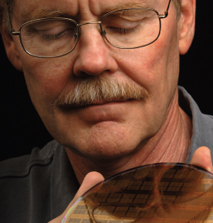
Arrays of tiny shutters made at Sandia are serving much the same purpose as home window blinds — helping regulate interior temperatures — aboard one of three small experimental satellites launched into space March 22 as part of NASA’s ST5 mission.
The mission’s purpose is to demonstrate innovative technologies for a new generation of autonomous microsatellites. (See “NASA’s ST5 mission” on page 4.)
Satellite designers pay special attention to electronics temperatures. If circuit boards get too hot, they can fail. If batteries get too cold, they can degrade faster or perform intermittently.
Temperatures inside satellites can fluctuate to both extremes, heating up when in sunlight or cooling way down when in Earth’s shadow, for example. The heat generated by the electronics themselves can be trapped inside the satellite.
Larger satellites have sophisticated, and heftier, thermal control systems. Smaller ones, like the 25 kg (55 lbs) ST5 experimental microsatellites, each roughly the size of a wedding cake, require smaller, lighter-weight, and, ideally, lower-tech approaches.
Fortuitous meeting
In 2001 researchers from Johns Hopkins University’s Applied Physics Lab were attending a MEMS (microelectromechanical systems) short course at Sandia when the need for innovative microsatellite thermal control methods came up. The visitors were part of a Johns Hopkins team supporting the then-planned ST5 mission.
A collaboration was launched, and Sandia project lead Jim Allen (1769) and a team of Sandia MEMS designers worked with the Johns Hopkins researchers to design, using Sandia’s SUMMiT V™ technology, a MEMS device featuring a moving grillwork of shutters with slats that are
6 microns wide and 1,800 microns long. A human hair is about 100 microns thick.
The arrays of small shutters, moved back and forth by electrostatic actuators, expose either the gilded and highly reflective grillwork surface or a dark silicon substrate to maximize or minimize heat transfer through the satellite’s skin as needed.
The electrostatic actuators, themselves arrays of intermeshing, spring-loaded comb’s teeth pulled together by electrostatic attraction, are a proven micromotion staple also developed at Sandia.
Louvered satellite skin
Two of the three ST5 satellites have on their top and bottom decks 4-inch-square arrays of micro-louvers. A single array includes some 2,600 individual electrostatically driven devices. Each device — grillwork and actuator together — is approximately the size of the cross on this letter “t.”
Sandia’s Microelectronics Development Laboratory (MDL) fabricated and delivered to Johns Hopkins in October 2002 twelve louver-laden wafers for the ST5 satellites. Johns Hopkins performed the packaging, integration, and space-qualification testing.
Each array weighs just grams and consumes nanowatts of power when changing states, from open to closed or vice versa, and no power (only voltage) to maintain a position.
In all, Sandia has 90 square centimeters of louver-skin flying aboard two of the three microsats, which have been in an elliptical polar orbit 200 to 3,000 miles above the earth since March 22. The three-month experimental mission ended June 22, but as of Lab News press time the satellites continued to operate.
“The MEMS variable-emittance louvers have performed successfully during their three month mission,” says Ann Darrin, program manager at Johns Hopkins Applied Physics Lab. “This is the first time a fully space-qualified device of this type has ever been flown [in space], and the first to be flown on the outside of a satellite.”
Ten new tools
As a result of ST5, spacecraft designers have 10 new tools to work with, says Ray Taylor of NASA’s Science Mission Directorate, speaking of the 10 new technologies flown on the mission. “And tools that are not only smaller, lower power, and less expensive, but because of ST5 they will be proven in space,” he says. “Therefore, they can be used with a high degree of confidence in future missions.”
“I’m kind of in awe that these MEMS devices are in space,” says Jim. “It’s a pretty cool milestone for MEMS devices. I think it’s great that Sandia could be a part of it.”